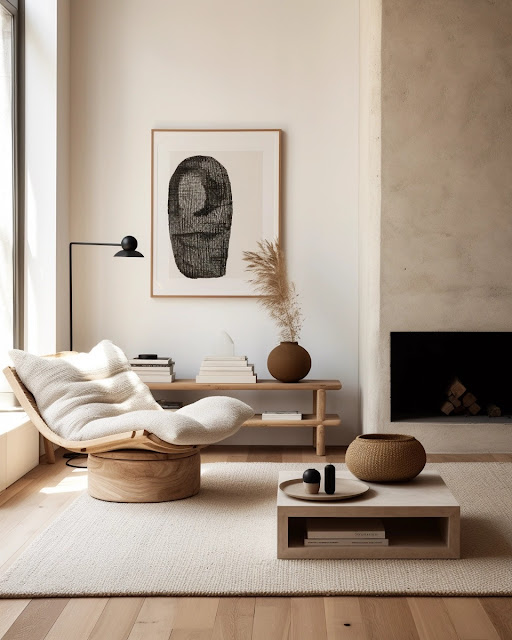A Guide to Japandi Style
In the ever-evolving world of interior design, one style that has gained significant attention and admiration is Japandi. A harmonious blend of Japanese minimalism and Scandinavian warmth, Japandi brings together two distinct design philosophies to create spaces that are not only aesthetically pleasing but also serene and functional. In this blog post, we will explore the history, principles, and the rise in popularity of Japandi, offering insights on how to incorporate this hybrid style into your own living spaces.
The Origins and Early Development
Japandi, a portmanteau of "Japanese" and "Scandinavian", finds its roots in the desire for simplicity, functionality, and a connection with nature. The Japanese philosophy of wabi-sabi, which embraces imperfection and impermanence, meets the Scandinavian design principle of hygge, emphasising cosiness and comfort.
While it might seem like a fairly new style, we can trace its origins back to about 150 years ago when Japan first opened its door to the world, and Danish artists and designers started visiting it in search for new inspiration. If you ask me, it's no wonder they were so impressed by what they saw because the two styles already share some principles that make them recognisible.
Wabi-sabi, originating from Zen Buddhism, values the beauty of imperfection and embraces a sense of rustic simplicity. It appreciates the natural cycle of growth and decay, encouraging a connection with the environment and a celebration of the aging process. Hygge, on the other hand, hails from Denmark and Norway, emphasising warmth, comfort, and a sense of well-being. It encourages creating cosy, inviting spaces that promote relaxation and connection.
The combination of wabi-sabi and hygge in Japandi results in a design style that prioritises a balanced, clutter-free environment while incorporating natural elements to evoke a sense of calm and tranquility. This harmonious coexistence of two cultural design philosophies became popular in the mid-2010s and has since become a global design phenomenon.
Key Principles of Japandi Design
Simplicity and Functionality: At the core of Japandi design is the principle of simplicity. Spaces are decluttered and streamlined, with a focus on essential elements. Furniture and decor are chosen for their functionality, promoting a sense of purpose and efficiency.
Natural Materials: Japandi places a strong emphasis on the use of natural materials such as wood, stone, and bamboo. These materials not only contribute to the aesthetic appeal but also establish a connection with nature, a key aspect of both Japanese and Scandinavian design philosophies.
Neutral Color Palette: The color palette in Japandi interiors is muted and neutral, often featuring earthy tones such as soft grays, whites, and warm beiges. This choice of colors creates a serene and calming atmosphere, contributing to the overall sense of tranquility.
Balance of Contrast: Achieving balance is crucial in Japandi design. This is evident in the interplay of light and dark elements, smooth and textured surfaces, and modern and traditional motifs. The juxtaposition of these contrasts creates a visually appealing and harmonious space.
Craftsmanship: Japandi celebrates craftsmanship and handmade elements. From handmade ceramics to carefully crafted wooden furniture, this style values items that tell a story and showcase the mastery of the artisan.
The rise of Japandi can be attributed to the increasing global interest in minimalism and the pursuit of mindful living. As people seek refuge from the fast-paced, modern world, the Japandi style provides a sanctuary where simplicity, functionality, and comfort converge.
Additionally, the versatility of Japandi makes it adaptable to various living spaces, from small apartments to larger homes. Its universal appeal has attracted a diverse audience, further propelling its popularity across the globe. Social media platforms and design publications have played a significant role in spreading awareness and appreciation for this unique fusion style.
Incorporating Japandi Into Your Space
Declutter and Simplify: Begin by decluttering your space and adopting a minimalist approach. Keep only the essentials, and ensure that each item serves a purpose.
Natural Elements: Integrate natural materials into your decor. Choose wooden furniture, stone countertops, and bamboo accessories to bring the outdoors inside. Plants, both large and small, add a touch of nature and contribute to the overall tranquility of the space.
Neutral Color Palette: Embrace a neutral color palette dominated by soft grays, whites, and earthy tones. This creates a serene backdrop and allows for the incorporation of various textures without overwhelming the space.
Balance and Contrast: Pay attention to the balance of contrasting elements. Mix modern and traditional pieces, incorporate light and dark accents, and experiment with smooth and textured surfaces to achieve a visually interesting and harmonious environment.
Handcrafted Touches: Introduce handcrafted elements, such as handmade ceramics, woven textiles, or artisanal furniture. These unique pieces add character to your space and celebrate the beauty of craftsmanship.
Quality Over Quantity: Invest in quality furniture and decor that will stand the test of time. Japandi design values longevity and durability, so choose pieces that not only look good but also serve a practical purpose.
Soft Lighting: Incorporate soft, diffused lighting to create a cosy and inviting atmosphere. Consider pendant lights, floor lamps, or table lamps with warm-toned bulbs to enhance the hygge aspect of your space.
Now for some shameless self-promotion (as one of my choir conductors likes to say) - if Japandi resonates with you, Studio Haustor is exactly where you should be looking for those perfectly imperfect home decor pieces.






Comments
Post a Comment
Share your thoughts with me!